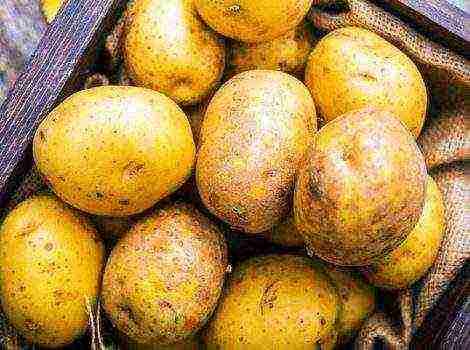Content
- 1 The benefits of olive oil for the body
- 2 Product manufacturing process (in brief)
- 3 Extra Virgin olive oil: main characteristics
- 4 Other types of olive oils
- 5 Cooking applications
- 6 How to choose a good olive oil, not a substitute
- 7 Which brand of olive oil is best
- 8 The best brands of olive oil from Greece
- 9 Olive oil from Spain and Tunisia: what are their specialties?
- 10 Italian product varieties
- 11 "Wood" oil
- 12 Laboratory work
- 13 How to choose the best olive oil?
- 14 Variety
- 15 the date
- 16 Package
- 17 Compound
Which brand of olive oil is the best? The answer to this question requires preliminary study. After all, the olive tree is not grown in Russia. Therefore, all olive oil is imported. But, as in the case of sunflower or corn, we know that the best product comes from the first pressing. We also know that vegetable oil is purified from impurities - refined. Is this good for olive? There are also spinning methods - cold and hot. Which product is better quality? In this article, we will comprehensively explore this issue. Below we will tell you not only which brand of olive oil is better, but also consider the products of the producing countries, we will briefly explain what the process of processing olives is. On store shelves, you can see various types of containers with these imported goods. Glass, plastic or metal - in which packaging should you buy olive oil? It is important to learn how to read the label correctly. And in this article we will explain what the words Eextra Virgin mean. In Mediterranean cuisine, where olive oil is one of the staple foods, it is widely used for many different purposes. You need to know these subtleties in order to properly season salads or make dough.
The benefits of olive oil for the body
Did you know that Mediterranean cuisine is included in the UNESCO list of intangible heritage of humanity? Do you know why? That's right: it is built on the active use of olive oil. Thus, Mediterranean cuisine is not only delicious, but also very healthy. Olive oil (reviews of gourmets and chefs in this matter are almost the same) will not only give the most ordinary food a noble shade - it will also saturate the body with valuable vitamins and minerals. And most importantly, it will not leave any extra centimeters on the hips and waist. After all, olive oil is completely processed by the stomach. Have you noticed what luxurious hair Italians, Spanish women, Greek women have? Strong, thick, silky, shiny ... And this is the result of daily consumption of olive oil. It strengthens bones, nails and teeth. Vitamin E, which is found in excess in olive oil, prevents aging, relieves pain in ulcers and gastritis, heals hemorrhoids, breaks cholesterol plaques. And even, as recent studies have shown, it is a good tool for the prevention of cancer. Therefore, the ancient Greeks, who cultivated olive trees in ancient times, called olive oil “the gift of the gods”. As you can see, this is not only a poetic metaphor.
Product manufacturing process (in brief)
To understand which brand of olive oil is better, you need to at least superficially understand the technology for obtaining this product. It would seem, what difficulties can there be? After all, olive oil has been made since the days of Ancient Egypt. The olives were put under a press and squeezed. But modern equipment and chemical reagents make it possible to squeeze more oil out of the olives. For this purpose, the cake goes for secondary processing. It is on this basis that olive oil is divided into two types. At the first spin, the "virgin" or Virgin Oil is born.And when olives are recycled, that is, they are heated and chemical reagents are passed through the cake, we get Pomace Oil. Based on the above, let's ask: is it worth talking about which olive oil is better? Of course, "virgin". But if we want to taste the finest olive oil, we must consider where the olives ripen best. After all, trees have a wide growing area. But they do not give a good harvest everywhere. The most reputable olive oil producing countries are Greece, Italy, Spain and Tunisia. The first, once called Hellas, accounts for eighty percent of Virgin Oil's global sales. Greek oil is purchased by importers for further production of the product.
Extra Virgin olive oil: main characteristics
Regardless of the country of origin, this product is the best possible. The very word "extra", mentioned in the title, indicates that the raw materials for it were of exceptionally high quality. The olives for this oil are harvested by hand. Then the crop is sorted. For Extra Virgin, only fully ripe, large and undamaged premium olives are selected. Next, the berries are sent to the press. No other influence occurs during processing. This process is called cold pressing. Thanks to this minimal processing, all the beneficial substances are retained in the oil. It is a slightly greenish product. Extra Virgin olive oil has a rich olives smell. But his taste is specific. People who have tried Extra Virgin Oil for the first time may think that the oil is gone, rancid. But just this taste testifies to the highest quality of the product. Raw olives are bitter too. But the free acidity of Extra Virgin Oil olive oil is very low - 0.8 percent. That is, one hundred grams of the product contains less than a gram of substances undesirable for the body. But this indicator - acidity - is not the main factor in determining a quality product. The refining method also reduces it.
Other types of olive oils
There are many more denominations between Extra Virgin and Pomats Oil. Let's consider them briefly.
Virgin Olive Oil is also a very high quality olive oil. The only difference with Extra is the less thorough casting of the crop. Olives of various sizes, ripeness and types are used for the press. But the rest of the process is exactly the same as in the production of Extra Virgin Oil. That is, the berries are cold pressed, after which the liquid is immediately poured into containers for sale. This oil is notable for the fact that it almost does not taste bitter. If you want to take it in its pure form for medical reasons, but cannot tolerate a specific taste, get this particular form. Virgin Olive Oil has a higher acidity. Two percent is allowed. But if this figure exceeds the norm, the batch is sent for purification. And here it is necessary to explain how refined olive oil differs from unrefined olive oil. In the production of the first product, chemicals are already used that cleanse it of excessive acidity. This figure for Refined Olive Oil is reduced to 0.3 percent. On sale there is also such a form as "Pur Olive Oil". The name translates as "pure olive oil". But this cold-pressed product is still a mixture of Virgin and Rafinid. The acidity of this olive oil does not exceed one percent. Well, Pomace Oil in Greece and Spain greases doors. Sometimes the product obtained from the heat extraction of the cake is refined.
Cooking applications
In the art of cooking, you should know for what specific purposes to use a particular type of olive oil. Especially in the northern countries, where this product is imported, and therefore very expensive. So, olive oil for salads should be taken only "Extra Virgin". By the way, it loses its bitterness in dishes. And over time, too. But the shelf life of the Extra Virgin bottle is one and a half to two years (depending on the container).At the end of this term, the oil does not lose its extremely useful properties, but it becomes softer, velvety in taste. For the preparation of cold sauces and marinades, we use the usual "Virgin". This olive oil is called very tasty and healthy by reviews. Meat greased with Virgin Oil will quickly soften and become tender after baking. For stews, use Pur Olive Oil. And for frying food, you should take the form of Refined Olive Oil. This oil, due to purification, has a high smoke point. It does not splash, does not fade, and does not generate a large amount of carcinogens in fried foods. This product is also ideal for making dough. It is not bitter and can be used in place of corn or sunflower. Olive Oil-based buns and breads do not stale for a long time.
How to choose a good olive oil, not a substitute
Supermarket shelves are littered with various brands of this product. Here it is just right and confused. How to make the right choice? Rule one: we carefully study the label. It is advisable that the product is packaged by the manufacturer himself. Olive oil from Greece bottled at Deribasovskaya Street is likely to be of dubious quality. The name is indicated on the label, often representing the type of product. That is, in capital letters it is written, for example, "Extra Virgin" or "Pur Olive Oil". Sometimes the name contains the brand of the manufacturer or the name of the area where the olives were harvested. But the type of product is also on the label. In oils that do not belong to the elite "Virgin", the type of processing is indicated. This also gives us the opportunity to choose the best product. It is better to buy cold-pressed oil than refined, but made from cake after heat treatment. The shelf life of the product is also of great importance. After all, this is not a wine that gets better with age. Extra Virgin has a shelf life of up to two years, other varieties - one year. But the color does not matter. Yes, it is often not visible due to the fact that the oil is poured into cans or dark glass bottles. Only a product of a low price segment is sold in plastic containers.
Which brand of olive oil is best
Olives grow in warm countries of Europe and Asia Minor, in North Africa. However, only four countries are leaders in the supply of olive oil to the world market. These are Greece, Spain, Italy and Tunisia. Which country of origin should you choose? You should be aware that breeders have developed many varieties of olives. And in Italy there are more than forty of them. Therefore, different companies have the opportunity to produce mono-varietal oils, as well as refined, with an amazing taste "cocktails".
The producers of Spain are adherents of the good old olive, which has been cultivated in Iberia since ancient times. Therefore, this country does not have such a variety of olive oil. Spain prescribes labels in its own language. Therefore, you need to coordinate Olive Oil with Aceite de Oliva. Please note that Aceite de Orujo means re-pressed oil, made from cake, created by heat treatment.
Olives in Greece grow in regions of different climatic characteristics. Terroir affects the flavor of olive oil, even if it is of the same type.
A product from Tunisia is very rare to find on the shelves of our stores. But this does not mean that the olive oil from this country is bad. On the contrary, the alternating influence of winds from the Sahara and the breezes of the Atlantic allows olives to be grown with a special taste and aroma.
The best brands of olive oil from Greece
Any product from sunny Hellas will be good. The choice before the buyer is truly huge. You can buy oil both from the olive groves near Thessaloniki and from the islands. And this, at least slightly, will affect the taste. The largest world trader that supplies olive oil not only to importing countries, but even to Spain and Italy, is Oliko. However, this company buys crops from various farms in the country and produces a certain mix (albeit of good quality).But the company "Elinika Eklikta Elya" was specially created in order to produce the best varieties of olive oil. Just as wine tours are thriving in France, so are small family run businesses in Greece. Companies such as Xylouris and Kidokinatis not only harvest olives by hand, but also crush them through a traditional press.
Olive oil from Spain and Tunisia: what are their specialties?
There are about fifty names of products from this country on the Russian market. What are the best Spanish olive oil brands? Look at the terroir. The climate of the south of the country, with its long vegetative period, makes it possible to grow the most juicy, fatty olive. The best brands are the Andalusian Baena and Lucena, as well as Les Garriguez and Siurana from Cordoba. On the other side of the Mediterranean Sea, in Tunisia, African Dream Products is considered the best olive oil producer. And his best brand is "Chemlali".
Italian product varieties
In this country, food is treated with reverence. It is not without reason that Italian cuisine is considered one of the best in Europe. By default, the products of this state are equated to the standard. Therefore, food products that are produced in Italy often become participants in all sorts of competitions for the title of the best. Manufacturers of olive oil also do not stand aside. They have their own competition - Ercole Olivario. Only elite varieties (Extra Virgin or at least cold pressed oil) can take part in it. What manufacturers have become - and more than once! - winners of this most prestigious competition in Italy? These are brands such as Azienda Agricola Giorgio, Oliveto di Contessé Gertrude and Fattorie Greco.
Olive oil is one of the most expensive among vegetable oil: for 250 ml of bitter oil from first cold-pressed olives ("extra-virgin olive oil") you will have to pay from 200 to 600 rubles. With this money, you can buy from 3 to 10 bottles of classic sunflower oil.
We decided to find out if it makes sense to pay that kind of money. Do they sell cheap counterfeits made from the same sunflower under the guise of healthy Mediterranean oil with the image of a healing product? The experts of the Society for the Protection of Consumer Rights (OZPP) purchased eight bottles - from Spain, Italy, Greece and Tunisia - and sent them for examination to the Sergiev Posad branch of the FBU “CSM of the Moscow Region”.
"Wood" oil
Olive oil is also called Provencal or "wood". It is the basis of Mediterranean cuisine, it is used for the production of soap, it is included in the most expensive cosmetics and some medicines. And in itself it is a medicine. This was known in antiquity. "Olive oil is beneficial due to its high content of monounsaturated fatty acids, especially oleic acid," says nutritionist Alexey Kovalkov... - This acid actively reduces the level of "bad" cholesterol and at the same time maintains the desired level of "good". Therefore, Provencal oil is recommended for the prevention of atherosclerosis. It is also useful for those who suffer from liver and gallbladder diseases, because it perfectly stimulates the production of bile. Olive oil is irreplaceable in baby food because it promotes bone growth. "
However, all of these properties are possessed exclusively by unrefined cold-pressed oil. It can be tart, slightly bitter, and has a greenish color. It is obtained by pressing, without the use of chemicals that easily "pull" the oil out of the crushed olive pulp. Refined oil is much worse for its medicinal qualities - after all, it is refined using various physical and chemical processes in order to eliminate the harsh taste and smell. Pomace oil (on the packaging it says "pomace olive oil") is obtained from pressing with the use of chemical solvents, and often under the influence of high temperatures. There is no use in it. This is usually reflected in the price - such a product is 3-4 times cheaper than the valuable "extra-virgin olive oil".
Laboratory work
To be sure that this is really olive oil, you need to investigate its fatty acid composition. In the laboratory, we tested ten basic acids in each sample. The most important of them is oleic. In accordance with GOST 30623-98 "Vegetable oils and margarine products" it should be from 56 to 83%. “But if the composition in a large amount is determined by its trans-isomer (the same acid, but with a modified molecule that arose under the influence of high temperature. - Ed.) Elaidic acid, most likely, the oil was obtained not by“ cold ”pressing, but with the help of thermal or chemical extraction, - says Roman Gaidashov, food expert at OZPP... - Trans isomers are present in the product in negligible amounts. But the Russian GOSTs do not have standards for trans-isomers, and such extended studies are not mandatory, for example, when verifying the authenticity of a product. " By the way, it is precisely because of the formation of trans isomers of fatty acids with carcinogenic properties during heating that it is impossible to fry in unrefined olive oil - only refined olive oil is suitable for this.
So, judging by a certain amount of oleic acid (see table), oils are really made from olives. The less elaidic acid in the sample, the better (we determined it in the amount from 0.2 to 0.4%). In none of the oils in the laboratory was found a dangerous concentration of heavy metals (checked for the presence of cadmium, lead, arsenic, mercury, copper and iron).
It is also important that the purchased oil is fresh. Indeed, with long storage, the product is oxidized, and the benefits literally disappear. It is possible to determine the freshness of oil under laboratory conditions by two indicators: acid number and peroxide number: the closer their values are to the upper limit of the norm, the more mature the oil. In our table, we have ranked oils in order of deterioration in quality. The main outsider is a product from Tunisia. Firstly, the real acid number does not coincide with the one stated on the package (which means that the oil is not as "extra-class" as promised!), And secondly, the peroxide number is 10 - this is the maximum allowed, the oil is not so fresh. The oil from Greece was not the best either. But the product from Italy and Spain is of the highest quality.
How to choose the best olive oil?
When choosing olive oil in a store, carefully inspect the packaging! Look for the following data on it:
Variety
There are six varieties of olive oil (they are defined by the IOC, the International Olive Council; all exporting countries that are part of it are required to label the products with the appropriate inscriptions):
| You can store olive oil at any temperature up to 35 ° C. It is not afraid of room temperatures or freezing and does not lose its beneficial properties after cooling. |
■ Extra-virgin olive oil - natural, the best and most expensive, the first cold pressing, only under pressure - no chemicals. Acidity not more than 0.8%.
■ Virgin olive oil - also natural, but the permitted acidity is up to 2% (pressing may not be the first, but the absence of chemicals is also guaranteed).
■ Pure olive oil - usually a mixture of refined and natural oils, chemical extraction can be used.
■ Olive oil - a mixture of natural and refined oil, acidity no more than 1.5%, usually odorless, chemically pressed.
■ Olive-pomace oil - refined oil extracted from olive oil cake (chemical solvents and high temperatures can be used). It is more commonly used in restaurants for baking.
■ Lampante oil - olive oil not intended for human consumption.
Refined oil is marked "refined".
the date
Date of production. Use only the freshest oil. Useful substances are stored in it for the first five months from the date of production. After the first year of storage, it is better to use olive oil exclusively for cooking (stewing and frying), but not for dressing dishes. In addition, over time, oils deteriorate and fizzle out. One year old oil may still taste good, but it is less aromatic than fresh oil.
Package
■ Indication of the acid number on the packaging. For "extra virgin" it is not more than 0.8%, while the lower the value, the better.
■ The packaging material matters. It is best to buy oil in dark glass - green or brown. After all, it is important not to allow contact of olive oil with air, as well as protect it from light - they spoil the product. Plastic or metal packages are considered cheaper.
Compound
Be sure to pay attention to this line. There are oils with herbs and spices (for salads), and cheap options may contain impurities of other vegetable oils. Such oils are labeled "mixed oil" or simply "mix". Usually they honestly write about this on the packaging, but not in large letters on the front of it, but small and inconspicuous.
|
A place |
Name |
Characteristics in the rating |
Olive oil is a unique gift from nature. This fragrant product, filled with the bright southern sun, can be useful in any of its qualities. The oil is actively used for the preparation of delicious and nutritious dishes, it is used in cosmetology, alternative medicine and dietetics. Due to its composition, which is dominated by oleic acid, olive juice is able to significantly strengthen the human body, prolonging its performance and youth for many years. In addition, the oil contains such vital fatty acids as Omega-3 and Omega-6, as well as phytosterols, vitamins A, D, E, K.
Of all the characteristics of "liquid gold", only one can be conditionally called a drawback - this is the price. Indeed, olive oil is the most expensive vegetable oil, and this is explained not only by its high demand, but also by the laboriousness of the process of collecting and processing fruits, as well as the large amount of raw materials required for preparation.
Olive oil is not produced in Russia, therefore, only foreign bottled goods are available for sale. How to make sense of the variety of bottles labeled "Olive Oil", because in the supermarket you are unlikely to be allowed to taste the product. Here are some tips to help you navigate and choose the best olive oil for your table.
- Processing type. The highest quality is the first cold pressed oil, extracted by mechanical processing of olives (that is, by hand). On the label, this variety is denoted by the phrase Extra Virgin.
- Package. The sun's rays negatively affect the quality of any fats, impairing their organoleptic characteristics. Choose olive oil packaged in opaque glass or tin cans.
- Production region. Despite the fact that the olive growing area is quite extensive, experts distinguish three countries in which the best olive oil is produced. These are Greece, Spain and Italy. The next positions are occupied by France, Tunisia, Turkey and Egypt.
Our review of olive oils includes the most popular brands, the reputation of which allows us not to doubt the quality of the products they sell. When making the rating, we took into account such characteristics as composition, environmental friendliness, taste, color, smell, consistency, country of origin, and also took into account the ratio of volume and cost of the finished product.
The best olive oil produced in Spain
Spain is one of the leaders in the production and export of Extra Virgin olive oil. There are about 30 regions in the country, in which this high-quality product has been produced for many hundreds of years, and this happens under strict state control. The taste of Spanish oil is as close to natural as possible, it is the most intense and spicy, it has a bright aftertaste.
4 IBERICA OLIVE POMACE OIL 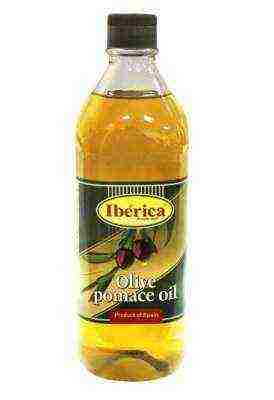 The most economical option for Spanish oil. The perfect choice for deep frying
The most economical option for Spanish oil. The perfect choice for deep frying
Country:
Spain
Average price:
440 RUB
Rating (2018):
4.7
The IBERICA trademark produces products, many of which have no analogues on the Russian market. A large assortment includes premium-class products and products of a more budgetary segment, but the difference in price does not in any way affect the quality characteristics.
One example of a product with a democratic value can be IBERICA OLIVE POMACE OIL - oil, which contains 85% refined and 15% Extra Virgin. This fresh juice is obtained after combining the second pressing of the fruits of the olive tree, during which a technology that allows high-temperature processing is used, and the Extra Virgen unrefined oil. As a result of this process, the overall acidity of the liquid decreases, and the necessary vitamins and minerals are returned to the composition, but in a slightly smaller amount.
This oil is ideal for large quantities. For example, to deep-fry vegetables or deep-fried cheese, which you would regret wasting a more expensive product.
3 MAESTRO De OLIVA EXTRA VERGINE  Quality marked by experts. Genuine relish and recognizable aroma
Quality marked by experts. Genuine relish and recognizable aroma
Country:
Spain
Average price:
774 r
Rating (2018):
4.8
Maestro de Oliva is a brand of the renowned Spanish food company Olive Line International S.L. Products of this brand can be bought in almost all regions of Russia. Their assortment is quite wide and includes, in addition to natural vegetable fats, a wide variety of Mediterranean snacks, seafood delicacies, different varieties of canned olives and olives.
Olive oil Maestro De Oliva Extra Virgin unrefined for its high quality and original taste was awarded a prestigious award given by the International Institute of Taste and Quality (iTQi). Information about this fact is located right on the label and confirms that the biological composition meets all international norms and standards. Olives of the Blanqueta variety, which are grown in Valencia and Alicante, are used as raw materials for the production of oil. Maestro De Oliva Extra Virgin does not have a bitter aftertaste, although, like any “live” product from natural raw materials, it can change its taste characteristics within the limits of acceptable standards.
Available in glass and tin packaging. The price depends on the volume and starts at 700 rubles. for 500 ml.
2 ITLV CLASICO 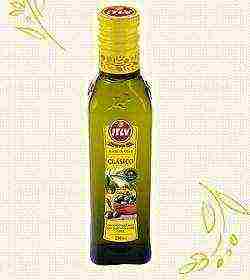 The best mix of oils. A versatile product for frying and dressing dishes
The best mix of oils. A versatile product for frying and dressing dishes
Country:
Spain
Average price:
254 r
Rating (2018):
4.9
The ITLV (Industrial Technologica Laintex Veterani) brand was specially developed by Borges for the sale of olives and vegetable fats on the Russian, CIS and Baltic markets. The goal of the company is long-term cooperation, therefore, in order not to lose the love and respect of the Russian consumer, the quality of products supplied by ITLV is always close to perfection.
ITLV Clasico is a blend of refined and unrefined oils. The liquid has a universal character, it can be used as an additive to ready-made dishes, and directly for frying meat, fish or vegetables. It is a natural ecological product without artificial additives, flavors and preservatives. It has a high smoke point, due to which a delicious crust is formed during heat treatment without the risk of burning.
The combination of two types of oils helped to reduce the natural bitterness of plant materials, so ITLV Clasico is ideal for people who do not like the astringency of natural olive.
1 BORGES EXTRA VIRGIN  Taste of the Mediterranean. Cold soft pomace
Taste of the Mediterranean. Cold soft pomace
Country:
Spain
Average price:
585 RUB
Rating (2018):
5.0
Borges brand products occupy about 60% of the Russian olive oil market. Founded in 1914, the company has been successfully developing all these years, and now it is one of the world leaders in the production of natural food products.
BORGES EXTRA VIRGIN oil belongs to the unrefined grade obtained as a result of mechanical first pressing. During its production, the raw materials were not exposed to high temperatures, which made it possible to maximally preserve all the benefits and freshness of the olives. The taste of the product may vary depending on the type of fruit and the weather conditions of the region where it was harvested and pressed.Most often, it ranges from neutral to bitter.
BORGES EXTRA VIRGIN is ideal for dressing salads and ready meals. Packaged in glass bottles of 250, 500, 750 ml, cans of 1 l, and plastic containers of 1.3 l.
The best olive oil made in Italy
Producers of Italian olive oil are sure that their products are the benchmark, and significantly differ from the products of other countries in their high quality and rich flavor bouquet. The reason for such a statement can be not only the experience of local craftsmen, but also the huge variety of varieties of olive trees grown in the country, which allows each province to have its own, unique taste of olive oil.
3 BIONATURAE ORGANIC EXTRA VERGINE OLIVE OIL 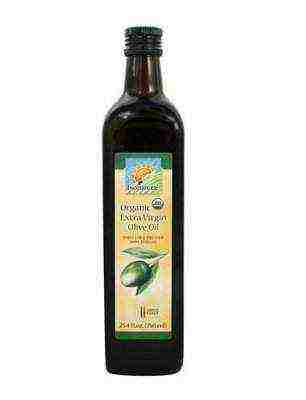 Organic food. Benefits and benefits of natural production
Organic food. Benefits and benefits of natural production
Country:
Italy
Average price:
RUB 3,290
Rating (2018):
4.8
A distinctive feature of organic ORGANIC EXTRA VERGINE OLIVE OIL from BIONATURAE is its authenticity. The product is made strictly according to old recipes and technologies that are carefully passed down from generation to generation, allowing a modern person to enjoy the truly natural taste of the olive tree.
The oil contains a mixture of the juice of five different varieties of olives grown on small family farms in Italy. The berries are picked by hand and at the very moment when they are fully ripe and ready to generously share their freshness and benefits with people. The natural naturalness and special aroma of olives ripened under the generous Mediterranean sun make this oil one of the best in the organic category. It is an excellent addition to any kind of food and an irreplaceable component of dietary nutrition.
The only drawback of ORGANIC EXTRA VERGINE OLIVE OIL is its high cost. For a 750 ml bottle, you will have to shell out more than 3,000 rubles from your pocket.
2 ALCE NERO EXTRA VERGINE DI OLIVA DOP 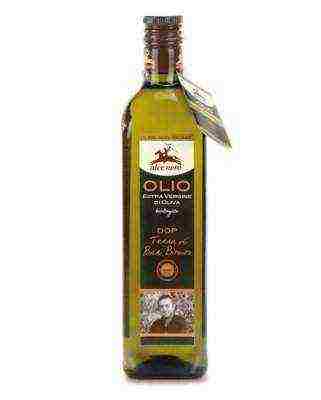 Cold pressed branded oil. One region of collection and bottling
Cold pressed branded oil. One region of collection and bottling
Country:
Italy
Average price:
1 344 rub.
Rating (2018):
4.9
Alce Nero is a renowned Italian natural food company. The company has a European quality certificate, which allows it to indicate the EU Organic Bio label on its products. The production of the company does not use genetic engineering techniques, and it is forbidden to use harmful chemicals on the fields of Alce Nero. fertilizers and pesticides.
The Italian oil EXTRA VERGINE DI OLIVA DOP ALCE NERO is made from olives that were grown, harvested and processed in the same geographic region. The absence of transportation and the minimum period of time from collection to filling guarantees a high quality product that does not lose even a fraction of its value.
The oil with an exciting bitter tint of fresh herbs perfectly meets the needs of the most demanding gourmets. The liquid is supplied in tinted glass bottles, with a volume of 750 ml.
1 MONINI EXTRA VIRGIN PESTO 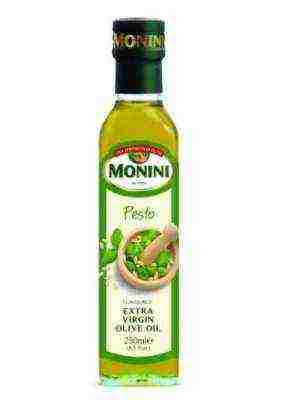 Refined seasoning with basil and pine nuts. The right base for pesto sauce
Refined seasoning with basil and pine nuts. The right base for pesto sauce
Country:
Italy
Average price:
529 r
Rating (2018):
5.0
The history of one of the flagships of the Italian food industry begins in 1920, when its founder, Zefferino Monini, returned from military service to his small town in the Umbria region. Created as a family business, today Monini is a world-famous brand that produces about 20 product variants, exporting its products to more than 50 countries.
The highlight of the company's product range is a special line of flavored olive oils, which are supplemented with natural spices, dry vegetables, mushrooms, nuts or herbs for added piquancy. MONINI EXTRA VIRGIN PESTO is a cold-pressed oil containing, along with the juice of high-quality olives, crushed basil sprigs and pine nuts.Additional natural ingredients give the product a unique exquisite taste, and allow it to be successfully used for the preparation of traditional homemade pesto sauce - a classic of Italian cuisine.
Like any delicacy, flavored oil is produced in small volumes. On sale you can find bottles of 250 ml at a price of 530 rubles.
The best olive oil produced in Greece
Greece is a small homeland of olive oil. The inhabitants of this particular country were once the first to appreciate its exceptional taste and notice the ability to have a beneficial effect on the human body as a whole. Due to the variety of climatic conditions inherent in different regions of Greece, the structure of the produced product can vary greatly depending on the region where the olive grows. The best oil from Greece has a bright rich taste with hints of honey and fruit.
3 KURTES EXTRA VIRGIN PDO 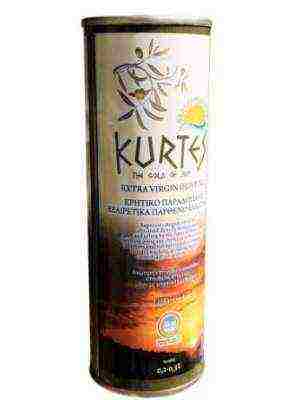 Farmed product with low acidity. Can be used for medical purposes
Farmed product with low acidity. Can be used for medical purposes
Country:
Greece
Average price:
RUB 550
Rating (2018):
4.8
It is known that the ancient Greeks revered olive juice not only as a delicious food supplement, but also attributed to it the properties of curing a lot of ailments, especially those associated with the activity of the digestive system. And until today, the use of high-quality olive oil for therapeutic and prophylactic purposes is no less important.
A small family-owned manufactory called KURTES is located in Crete and focuses on the production of exclusive, environmentally friendly products that can be used both in cooking and for general health improvement. KURTES EXTRA VIRGIN oil has a PDO certificate, which means that the whole process of its production was carried out strictly at the place of collection of raw materials. The acidity level declared by the manufacturer is 0.2-0.3%, which is significantly lower than the recommended rate of 1% and characterizes the oil as a high-quality product, ideal for people with gastrointestinal problems.
The oil is supplied in glass and tin containers of 100, 250, 500, 1000 and 3000 ml. Price - from 210 rubles. for the smallest bottle.
2 GAEA GREEN & FRUITY  Fruity bouquet with ripe olives aftertaste. For true connoisseurs of fine cuisine
Fruity bouquet with ripe olives aftertaste. For true connoisseurs of fine cuisine
Country:
Greece
Average price:
RUB 765
Rating (2018):
4.9
GAEA's Greek olive oils are among the most titled in the world. The products of this brand have won many awards, including such prestigious ones as a gold medal at the International Competition in Japan and Germany, the title of the most innovative product in Greece, first prizes and awards of many other international competitions.
GAEA GREEN & FRUITY oil is made mechanically from selected fruits of the Koroneiki variety. The trees growing in the Sitia region, where the optimal weather conditions prevail for olive growth, bear fruit with delicious oil berries. The olives are harvested and processed by hand, resulting in a thick, high-quality juice with a high concentration of beneficial compounds. The taste of the liquid is very rich, tart, with a slight bitterness. The consistency is thick, the color is emerald green.
Oil is poured into half-liter containers made of dark thick-walled glass. The original design of the bottle creates the feeling of owning a real rustic product.
1 MINERVA KALAMATA EXTRA VIRGIN 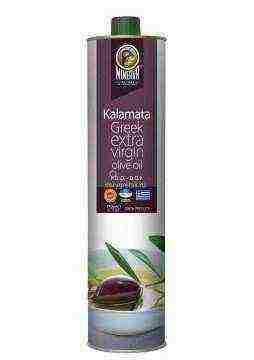 Olive juice from the Peloponnese. The best combination of price, volume and quality
Olive juice from the Peloponnese. The best combination of price, volume and quality
Country:
Greece
Average price:
RUB 785
Rating (2018):
5.0
Minerva entered the Greek market in 1900. Within a few years, the range of the brand's products went beyond the scope of domestic trade and began to conquer the hearts and stomachs of residents of several continents at once. Minerva Olive Oil is the standard of traditional Greek cuisine, combining ancient recipes with innovative technologies.
Minerva Kalamata Extra Virgin comes to our counters from the Peloponnese, Kalamata region, which is considered one of the priority areas in the world for the best varieties of olives. The main advantages of butter, according to buyers, are that it tastes good, does not taste bitter, and is great for both frying and cold dishes, side dishes, pasta and fresh vegetables. Lovers of healthy food also noted the affordable cost of the product, which in no way affects its high quality.
The oil is poured into opaque tin containers with a volume of 750 ml or more. This creates ideal conditions for storage and transportation. Price - from 650 rubles. for the can.
Comparison Chart of Olive Oil and Sunflower Seed Oil
Olive oil is a real elixir of health and youth, but our native sunflower oil is in many ways not inferior to a foreign "guest". We have compiled a comparison table showing the most important characteristics of these two herbal products.
|
Characteristics |
Olive oil |
Sunflower oil |
|
The energy value |
898 kcal / 100 g |
899 kcal / 100 g |
|
Saturated fatty acid content |
15 % |
13 % |
|
Content of polyunsaturated fatty acids |
10 % |
66 % |
|
Oleic acid content |
75 % |
22 % |
|
Vitamin E |
12 mg / 100 g |
40-60 mg / 100 g |
|
Smoke point |
177-204 ° C |
160 ° C |
|
Mode of application |
Salads, sauces, pasta, dressing for ready meals, light sautéing |
Salads, sauces, baking in the oven, stewing, frying, deep frying |
Attention! The above information is not a buying guide. For any advice, you should contact the specialists!
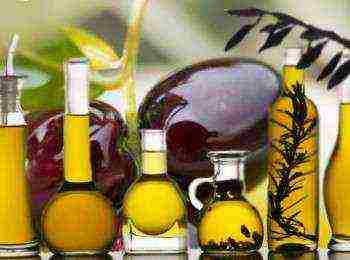 Coming to shops for purchases, especially in large supermarkets, each customer is faced with a wide range of products and, accordingly, with the problem of choice. This information on olive oil grades will help you to choose the best for your purposes and to orient yourself well in front of the counter. After all, when we go to buy a certain product, we roughly know how we will use it and in what dishes we will use it.
Coming to shops for purchases, especially in large supermarkets, each customer is faced with a wide range of products and, accordingly, with the problem of choice. This information on olive oil grades will help you to choose the best for your purposes and to orient yourself well in front of the counter. After all, when we go to buy a certain product, we roughly know how we will use it and in what dishes we will use it.
The gastronomic properties of olive oil depend on its retail variety. So, for example, if you need to improve your nutrition and make full use of the medicinal properties of olives, then you should be interested in the best olive oil. If you want to use it for stewing and frying food, then here you must also choose the right one for these purposes.
to content ↑ Acidity is the main quality indicator
It should be noted that the quality of this product depends on many indicators, and the most important of them is free acidity, which indicates the content of oxidizable organic acids in the final product. Acidity is usually expressed as a percentage by manufacturers, although it is actually stated in grams per 100 grams of ready-to-eat olive oil.
 The lower this figure, the more expensive the oil and the more useful it is for the vital functions of our body, although one should also take into account the following point: manufacturers can artificially lower the acidity. This is especially true for refined varieties where chemical solvents and reagents are used.
The lower this figure, the more expensive the oil and the more useful it is for the vital functions of our body, although one should also take into account the following point: manufacturers can artificially lower the acidity. This is especially true for refined varieties where chemical solvents and reagents are used.
back to content ↑ Olive oil grades markings
Let's start by looking at olive oil varieties - for a better orientation in their markings. Indeed, the gastronomic properties of the oil also depend on the variety - its taste, smell and ability to withstand temperature effects, while preserving useful substances.
All varieties can be divided into 3 classes:
natural - Virgin, peeled - Refined and secondary pressing of cake - Pomace.
The quality control and labeling of products is carried out by the International Olive Council, which has compiled a classification of olive oils and their designations on packages.

Extra Virgin Olive Oil
Extra Virgin Olive Oil is a first pressing product.
This is the best olive oil ever! This olive product has a free acidity of 0.8%, i.e. no more than 0.8 g of oxidizable organic acids per 100 g of the finished product.The processing process is carried out exclusively by mechanical methods of cold pressing of olives, excluding temperature effects leading to any changes in their properties.

Extra Virgin Olive Oil - the highest quality oil obtained using technologies dating back to the times of Ancient Egypt (the only difference is in the use of modern equipment). For pressing, only undamaged, most ripe olives are taken, which are harvested from the trees only by hand.
Virgin olive oil
Virgin Olive Oil is also a product of the first oil extraction.
A product with a free acidity of not more than 2%, which is obtained only by mechanical extraction methods and is purified without the addition of chemical reagents. For this pressing, fruits of different degrees of ripeness can be used, but if, as a result of pressing, an acidity index of more than 2% is obtained, then the entire pressing is sent for refining, as it does not meet the requirements for the Virgin class.
Refined Olive Oil
Refined Olive Oil - refined olive pressing. It is processed and cleaned with minimal change in its composition. Has an acidity of no more than 0.3%.
Olive Oil or Pure Olive Oil
Olive Oil or Pure Olive Oil is pure olive pomace.
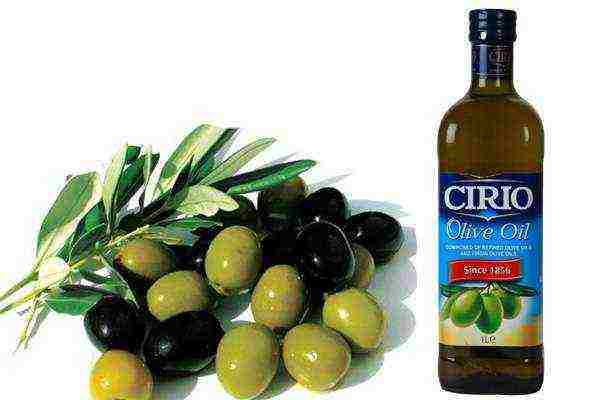
This blend of Refined Oil and Natural Virgin, with a free acidity of 1%.
Olive-pomace Oil
Olive-pomace Oil - secondary extraction from the remaining olive pomace.

This product is obtained from olive oil cake, which is processed both by various physical methods and by natural solvents. It is permissible to use not only natural solvents, but also chemical ones, as well as high temperatures.
Refined Olive pomace Oil
Refined Olive pomace Oil is a refined analogue of a pomace product.
This product is obtained from raw cake by processing methods that do not lead to changes in the basic properties of the final product. Free acidity - no more than 0.3%.
Olive pomace oil
Olive pomace oil - a mixture of refined pomace oil and a blend of various olive oils (unrefined and refined).
This product has a free acidity of about 1%. Not approved for sale to consumers in all countries. This product cannot be called olive oil, although it cannot be called unfit for human consumption. It is widely represented in our retail chains, especially under the brands of large retail supermarkets.
Which olive oil is the best is easy to understand by analyzing the classification of the expert International Olive Council, which is used by all leading olive oil producers.
back to contents ↑ Application in cooking
After examining all the labels of the oil, we can already move on to the question of using each retail grade. Remember when we said that oil should be chosen for specific purposes?
The healthiest way to consume olive oil is as a salad dressing. It can also be used as a main ingredient in marinades and cold sauces. For these purposes, Extra Virgin Olive Oil is more suitable than other varieties - a pure organic product with an impressive range of beneficial properties.

It should be noted that the fresher the Extra Virgin, the more bitter it is, and not vice versa! The product will have a distinct olive flavor, but with different shades, as it is obtained from different varieties of olives, maturity and crop areas. Within six months after the spill, the oil gradually loses its bitterness, becomes softer in taste. Extra Virgin shelf life is 1.5-2 years.
For stewing and frying products, we use Olive Oil, an excellent quality oil that can also be used for dressing salads and sauces. This type of product is ideal for cooking meat and vegetables as it does not generate carcinogenic substances. This is due to the presence of stable fatty acids in it, which increase the smoke point, which becomes much higher than the usual frying temperature.
Olive Oil also does not have a pronounced taste and smell of olives, does not taste bitter, therefore, all over the world it is preferred to be used in cooking more than others.
If you still want to switch to cooking using olive oil instead of the usual sunflower oil, but Olive Oil is too expensive for you, then Pomace Olive Oil may be an acceptable option for your family. Although it does not have such a rich composition as Extra Virgin Olive Oil or Olive Oil, it is of quite acceptable quality. It contains the same monounsaturated fatty acids, vitamins and minerals, but in smaller quantities.
Pomace Olive Oil is suitable for roasting and stewing and also demonstrates its best qualities in baking. Pastry products do not stale for a long time, remaining lush.
back to contents ↑ Medical and cosmetic applications
For cleansing procedures (taking oil on an empty stomach), use only Extra Virgin Olive Oil. For the preparation of oil infusions of medicinal herbs and other ingredients (infusions or macerates), only the highest grade of the product is also suitable.
In home cosmetics, as well as in factory cosmetics, only bottling from the first cold pressing - Extra Virgin Olive Oil is used.

Only this and nothing else!
So, to summarize:
In the markets of post-Soviet countries, you can find olive oil of three retail varieties:
- Extra Virgin Olive Oil - natural product of the highest quality
- Olive Oil - blend of natural Virgin oil and refined Refined Olive Oil
- Pomace Olive Oil - a blend of Refined pomace and Pure Olive Oil
The main producers of olive products are Spain, Italy, Greece and Tunisia. The largest volume (up to 80%) of Extra Virgin Olive Oil is produced in Greece. Greek production volumes are purchased by foreign companies for further use in mass production of the product.
back to contents ↑ How to choose the right olive oil
By name
The name may indicate not only the actual retail variety, but also the manufacturer's brand name. Also, natural olive oil can often be labeled with the variety of the olives themselves or the province of their growth. One way or another, the retail grade must be specified.
By label
The label must necessarily indicate the manufacturer, as well as the importer and exporter with phone numbers and addresses. High-quality olive oil is bottled by the manufacturer himself, so if it is produced in one country and bottled in another, then the quality of such a product may not correspond to the declared one.

Also pay attention to the date of bottling. Olive oil is not wine! Over time, it loses its healing qualities, especially for the Olive Oil variety. The maximum shelf life from the date of bottling is 12 months, with the exception of Extra Virgin.
By color
Choosing the right olive oil by color is impossible! The color of the product depends on various reasons and can range in color from light yellow to dark green, even brown. First of all, the color of the product is given by the condition of the olives themselves, i.e. their ripeness. If green olives are used for pressing the oil, the color will vary in different shades of green.
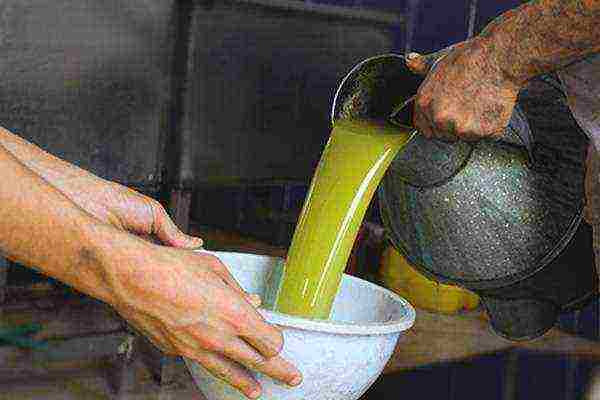
This product has a pronounced taste of olives and bitterness. If ripe olive fruits are pressed, the color will be yellow, often with a purple tint. A brown color is obtained if the pressing is obtained from the ripe fruits of the olive (often this butter has a slightly sweetish taste).
By packing
The traditional packaging is a dark glass bottle to protect the product from light and degradation. Disadvantages - fragility, weight and incomplete protection from exposure to light. Advantages - You can visually examine and evaluate the content.
A more modern and technologically advanced packaging is a tin can. The used metal sheet has a special coating, which completely excludes oxidation of the product. Advantages: does not transmit light, lightness and low cost. Disadvantage: Inability to evaluate the content.
We hope that after reading our detailed information on how to choose olive oil, and which is the best of all on our market, the choice will not be so difficult for you.
We wish you to consciously choose what to eat and how to eat!


